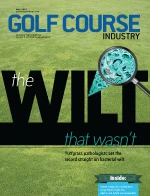| |
 Jeffrey D. Brauer Jeffrey D. Brauer |
Last month, I noted that designers in the early post-WWII era designed more with maintenance in mind, compared with designers of the 1990s and 2000s who favored visual splendor over practicality. Historically, practicality and cost dominates design, so it’s worth remembering the design details that make a maintenance-friendly course. Luckily, I often ask superintendents which features cost them the most time and trouble – and keep notes on the answers!
On a “bell curve,” the top 10 percent of courses should greatly favor design over maintenance, the bottom 10 percent of courses should greatly favor ease of maintenance over design and the middle 80 percent should be a practical blend between maintenance savings and design.
Superintendents and courses vary, so no single item is mandatory design criteria. Many others have high maintenance value no design impact, and should be included. Disclaimers aside, here is my ongoing list of design maintenance-friendly design features for your consideration:
Greens
- At least six real pin positions, 14 or more preferred for busy courses
- Gentle edge shapes (min. 25 -foot radius) and vertical transitions to reduce mower damage on cleanup pass maximum
- Maximum 17.5 percent slopes to surrounding mounds, between distinct green levels and on high points facing damaging winds
- Turf choice – No monocultures – select for hardiness, water conservation over color or putting
Greens Surrounds
Green Access
- Equipment – Transition slopes to mounds, ability to mow in all directions easily; 6 inches between green and bunker for turning
- Golfers’ access routes (from cart path) – Min. 30 feet wide, maximum 5 percent slope, 2 percent no cross slope; back half of green for circulation, speed of play; away from major drainage flows
Green Approach
- Sand cap and herringbone tile
- Adjust sprinklers so part circles don’t all stop at same place, causing overwatering
Bunkers
- Bunker-rake friendly (with no liners, or durable liners) – Multiple sand rake access points; match sand rake turning radius, normally 7-8 feet; flat enough to reduce sand wash from rain (varies by region, but max. 25 percent); no uphill drainage goes into bunkers; extensive herringbone tile.
- Banks and Noses – Match mowers’ turning radius and maximum slope (varies, but about 9-foot radius, 33 percent slope); if narrower, make “nose width” one mower-width wide for down and back mowing.
Tees
- Rounded tee edges easier to mow – 8-foot minimum radius
- Gentle tee banks – 4:1 or greater, but 3:1 okay, with transition slope
- Combine tee surfaces – large tee surfaces quicker to mow than several small ones.
Cart paths
- Broad curves to distribute exit traffic; allow truck to drive 15 mph (both at least 100-foot radius); wide access points to fairway (at least 30 feet)
- Minimum radius of intersections 55 feet (allows max. cart speed to stay on path)
- Curbing at tees and greens – 4-foot-roll curbs to allow maintenance equipment to pass; short (20 feet or less) curb areas concentrate foot traffic
- Drains/grading to keep surface and edges dry to reduce tire damage
- USE REBAR, DAMMIT!
Fairways
- Reduce fairway acreage – fairways cost more than rough, 30 acres is better than 45; narrow and starting as far from tee as possible
- Cut off drainage that flows cross fairway
- Provide good irrigation coverage, especially on cart path side; wide access routes (at least 30 feet wide)
Roughs
- Minimize in favor of natives
- Don’t minimize where it affects speed of play
- Provide irrigation, even if not for regular use
- Reduce mounds to increase mowing productivity
Trees
- Clear wide enough from critical areas – at least height of tree
- No trees on east sides of tees, greens, heavy circulation areas
- No shallow root or brittle bark trees, select for water conservation
Attention to construction details in implementing these schemes assists in making maintenance easier, but the list would be just as long.
|
 Jeffrey D. Brauer
Jeffrey D. Brauer





